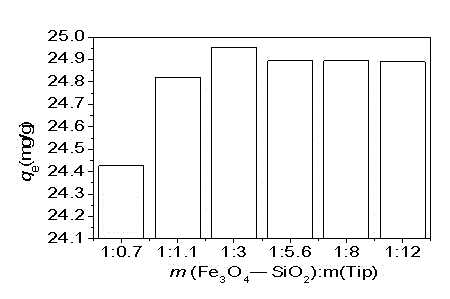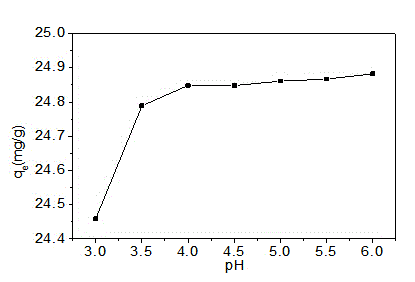Heavy metal ion high efficiency adsorbent, preparation method and application thereof
A technology of heavy metal ions and adsorbents, applied in the direction of non-metallic elements, chemical instruments and methods, adsorption water/sewage treatment, etc., can solve the problems of filter membrane clogging, low efficiency, increased operation difficulty and operating cost, etc., to overcome High cost, good governance effect
- Summary
- Abstract
- Description
- Claims
- Application Information
AI Technical Summary
Problems solved by technology
Method used
Image
Examples
Embodiment 1
[0044] 1. A high-efficiency adsorbent for heavy metal lead ions, which is a composite magnetic material TiP-SiO 2 -Fe 3 o 4 .
[0045] 2, the preparation method of the efficient adsorbent of heavy metal lead ion, it comprises the following steps:
[0046] (1) Add 4g FeCl to a 100mL beaker 2 4H 2 O crystals, add 60mL of absolute ethanol, stir to dissolve and set aside. Add 470mL of deionized water, 0.62g of solid sodium hydroxide (NaOH) and 0.4g of cetyltrimethylammonium bromide into a 500mL beaker, and dissolve them evenly. Slowly add the above dissolved FeCl under vigorous stirring 2 4H 2 O in absolute ethanol. Stop stirring after 5 minutes, and let it stand at 30°C for 30 minutes; slowly add 50mL concentrated ammonia water and 40mL tetraethyl orthosilicate to the above solution while stirring, raise the temperature to 45°C, stir for 6h, wash with deionized water until neutral, separate and dry at 60°C Dry at ℃ for later use.
[0047] (2) the Fe obtained by the abov...
Embodiment 2
[0050] 1. A high-efficiency adsorbent for heavy metal lead ions, which is a composite magnetic material TiP-SiO 2 -Fe 3 o 4 .
[0051] 2, the preparation method of the efficient adsorbent of heavy metal lead ion, it comprises the following steps:
[0052] (1) Add 8g FeCl to a 100mL beaker 2 4H 2 O crystals, add 120mL of absolute ethanol, stir to dissolve and set aside. Add 1000mL of deionized water, 1.2g of solid sodium hydroxide (NaOH) and 0.8g of cetyltrimethylammonium bromide into a 500mL beaker, and dissolve them evenly. Slowly add the above dissolved FeCl under vigorous stirring 2 4H 2 O in absolute ethanol. Stop stirring after 5 minutes, and let it stand at 30°C for 30 minutes; slowly add 100mL concentrated ammonia water and 80mL tetraethyl orthosilicate to the above solution under stirring, raise the temperature to 45°C, stir for 6h, wash with deionized water until neutral, separate and dry at 60°C Dry at ℃ for later use.
[0053] (2) the Fe obtained by the ab...
Embodiment 3
[0054] Example 3 lead ion adsorption removal test
[0055] Get 2 parts of industrial waste water containing 10L lead ion, drop into the TiP-SiO that the embodiment of the present invention 1 and embodiment 2 prepare respectively 2 -Fe 3 o 4 20 grams, adjust the reaction temperature to be 35°C, adjust the pH of the waste water to be 5, and the reaction time to be 120 minutes, respectively calculate the removal rates of lead ions in the waste water to be 90.2% and 90.7%, showing that the TiP-SiO prepared by the present invention 2 -Fe 3 o 4 The adsorbent has a good adsorption and removal of lead ions in wastewater.
PUM
 Login to View More
Login to View More Abstract
Description
Claims
Application Information
 Login to View More
Login to View More - R&D
- Intellectual Property
- Life Sciences
- Materials
- Tech Scout
- Unparalleled Data Quality
- Higher Quality Content
- 60% Fewer Hallucinations
Browse by: Latest US Patents, China's latest patents, Technical Efficacy Thesaurus, Application Domain, Technology Topic, Popular Technical Reports.
© 2025 PatSnap. All rights reserved.Legal|Privacy policy|Modern Slavery Act Transparency Statement|Sitemap|About US| Contact US: help@patsnap.com



